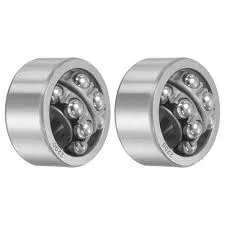
Dec . 15, 2024 08:19 Back to list
Design and Applications of Single Row Thrust Ball Bearings in Machinery
Understanding Single Row Thrust Ball Bearings
Single row thrust ball bearings are essential components widely used in various machinery and equipment. Their primary role is to bear axial loads in one direction, which makes them ideal for applications where thrust loads—that is, forces acting parallel to the axis of rotation—are predominant.
Structure and Design
A single row thrust ball bearing consists of three main parts the balls, the raceways, and the cage. The balls are the rolling elements that allow for smooth movement and reduce friction. The raceways are the surfaces on which the balls roll, providing a dedicated path that ensures stability during operation. The cage, or separator, is used to maintain the positioning of the balls and prevent them from coming into contact with each other, which could lead to wear and ultimately failure.
The design of these bearings enables them to handle axial loads effectively. However, it is crucial to note that single row thrust ball bearings are not designed to support radial loads. Hence, they are typically used in pairs or alongside radial bearings to handle cross loads.
Applications
Single row thrust ball bearings are found in various applications across different industries
. Common uses include1. Automotive They are often utilized in clutches, gearboxes, and even as part of the steering mechanisms. The ability to withstand axial forces while maintaining a compact design makes them particularly valuable in automotive engineering. 2. Industrial Machinery In equipment like cranes, conveyors, and pumps, these bearings provide the necessary support to handle heavy loads. Their robustness aids in reducing wear on other components, thus extending the machinery's lifespan.
single row thrust ball bearing

3. Aerospace In the aerospace industry, they are used in systems where precision and reliability are paramount. Their ability to manage thrust loads makes them suitable for applications such as turbine engines and landing gear assemblies.
4. Home Appliances Items like washing machines, fans, and electric motors often incorporate single row thrust ball bearings to enhance performance and efficiency.
Advantages
The advantages of single row thrust ball bearings are numerous. Firstly, they are designed to minimize friction, which results in smoother operation and reduced energy consumption. Secondly, their compact design allows them to be integrated into smaller spaces without compromising performance.
Additionally, these bearings are typically constructed from high-quality materials, such as stainless steel or chromium steel, which offers excellent resistance to wear and corrosion. This durability helps ensure a longer service life, reducing maintenance costs over time.
Limitations
Despite their advantages, single row thrust ball bearings also come with some limitations. Their inability to handle radial loads means they cannot be used in scenarios where both axial and radial support is required. It is essential for engineers and designers to consider these factors when selecting bearings for specific applications.
In conclusion, single row thrust ball bearings play a crucial role in many mechanical systems. Their unique design allows them to handle axial loads effectively, making them indispensable in various industries, from automotive to aerospace. Understanding their structure, applications, advantages, and limitations is vital for anyone involved in the design and maintenance of machinery. As technology continues to evolve, the development of even more advanced thrust bearing designs will likely enhance performance across many domains.
Latest news
-
Grooved Ball Bearing Design and Functionality
NewsJun.04,2025
-
Concrete Mixer Bearing Load Capacity Testing
NewsJun.04,2025
-
6004 Bearing Dimensions in Robotic Joint Designs
NewsJun.04,2025
-
Advantages of Single-Row Deep Groove Ball Bearings
NewsJun.04,2025
-
Applications of Deep Groove Ball Bearings in Automotive Systems
NewsJun.04,2025
-
Innovations in Bearing Pressing Machine Design
NewsJun.04,2025
